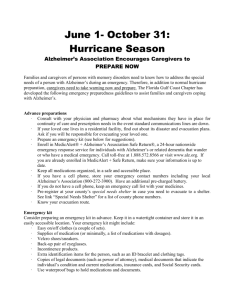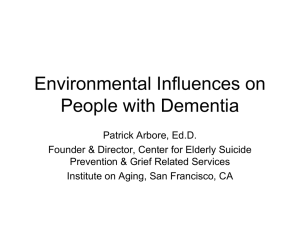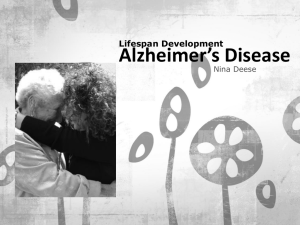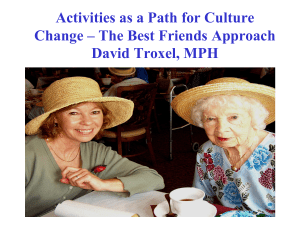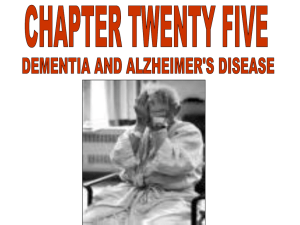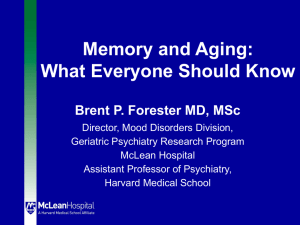File - Chaplain Miller Ministries
advertisement
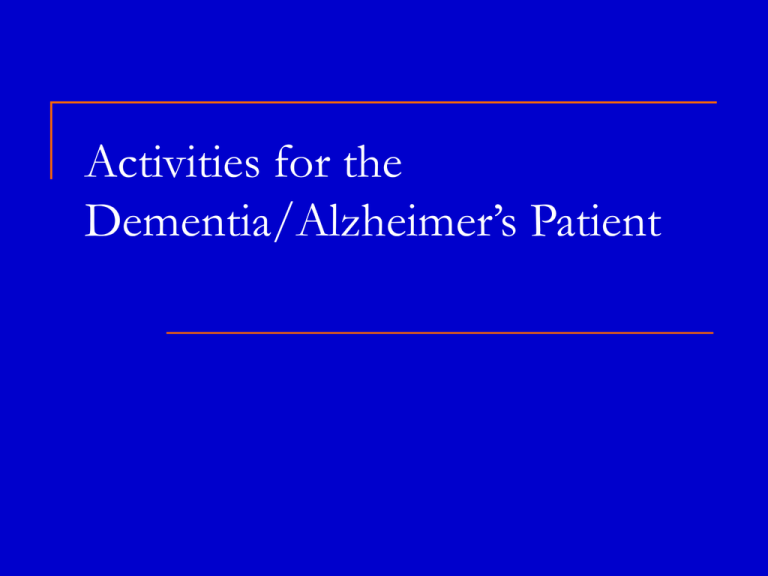
Activities for the Dementia/Alzheimer’s Patient Objectives The participant will be able: Discuss the Montessori-approach to activities and dementia patient Understand as families, caregivers, other members on planning & implementation of activities Facilitate improvement in patients, families, and caregivers daily lives through the use of activities Instruct families on challenges to be faced when planning & implementing activities Discuss resources for activities What we know today about activities & the dementia patient: The relationship to activity to the course of dementing illnesses is not clear. Many studies are on-going in this area Activity has many benefits and is preferable to most individuals Inactivity can often be associated with behavior problems When an activity is initiated, we walk a fine line between providing meaningful activity & overstressing the person (be careful!) The typical day for Alzheimer’s patient is often filled with… boredom obstacles mistakes failures …all due to memory lapses People with dementia.. May lose the ability to entertain themselves May not be able to organize everyday ADLs The caregivers of the patient, with all they are expected to do, may not have time or energy to organize activities…day care centers, other family, friends, or paid caregivers may be needed. Activities help… Raise quality of life Increase self-esteem Relieve boredom Reduce restlessness Raise self-awareness Increase alertness Decrease agitation Decrease depression & anxiety To be effective, activities must… Draw on remaining abilities & knowledge Provide cognitive & sensory stimulation Contain adult level activity as long as possible Be simple but entertaining Be short (20-30 minutes) Most Alzheimer’s patients are aware of their memory loss, and failing in a simple activity will only add to their frustration. Montessori-based approach Dr. Cameron Camp, research psychologist pioneered use of Montessori methods with Alzheimer’s patients Built on no-fail methods with emphasis on repetition and learning through the senses by manipulating materials Montessori-based approach (cont) The individual is considered as a whole • • • • • physical emotional social aesthetic spiritual Cognitive needs & interests are inseparable and equally important Dr. Cameron Camp says… “We can’t stop cell death from Alzheimer’s. But at any stage of dementia there is a range of capability. If you give a person a reason to get out of bed, activities that engage them and allow them to feel successful, they will be at the top of their game, whatever it is.” A true story… Dr. Camp was visiting an ALF and observed a 70-year-old woman. He gave her a book on Gene Kelly, the dancer. He asked her to read a page. “She took the book and read aloud— clear as a bell.” A shocked staff member called it a miracle—she didn’t know the woman could speak. Adapting Montessori exercises to older people with dementia The Objective: Tailor activities to patient’s background & interests The Benefit: This draws the “person” out of the “patient” Another true story… A research participant with Parkinson’s and dementia who was confined to a wheelchair had loved woodworking and fixing things. He was brought a small box to paint, nuts and bolts to put together, and puzzles. Where he used to sleep all day, he would smile and talk as he worked on his “projects”. “People with Alzheimer’s ‘live in the moment’, and our job is to give them as many good moments as we can.” -Dr. Cameron Camp Reading Studies have found that reading is one of the very last skills to fade away Reading is automatic—almost a reflex, according to Dr. Camp Print should be large & bold Activities should be meaningful—things that call on the person’s past. Boredom will result if the activity isn’t challenging or interesting. It is unrealistic to expect a person to learn new, complex skills; however, some individuals can learn simple tasks or facts if repeated enough times. Teaching others… One particular facility has Alzheimer’s patients teaching some simple activities they have learned to preschool children. The result is dignity, purpose, and fun as the elder interacts with the child. The patient who sees himself as a “helper” will have increased self esteem. Asking the patient to “assist” you is most likely to met with positive results. Intellectual skills are not all lost at once…assess what person can still do and make the most of remaining abilities. Most patients can participate in some way—whether stirring lemonade or participating in a conversation. Assessment of remaining abilities Can the person Read Sort Categorize Manipulate objects Customize activities based on these skills Simplify activities so that patient can be involved in some way For example… One patient loved baseball, so the staff had him sort pictures of baseball players into American and National leagues Another patient who loved opera sorted titles into operas by Puccini and operas by Verdi Research shows… …that people who engage in activities tend to exhibit fewer signs of agitation, depression, and anxiety. It can also improve the morale of the caregiver, knowing they are doing something useful for the patient. Other advantages of activities Maintenance of the motor skills necessary to feed themselves or button buttons Triggers memories & conversations that can connect patient with caregiver Decrease risk of boredom & resulting negative behaviors Risk for mistakes on part of patient & caregiver—try something else The most important thing is the enjoyment of the activity…not the correctness of the activity. Warning: Too much stimulation, activity, or pressure to learn may upset the confused person, may upset the caregiver, and may accomplish nothing. Withdrawal may be a person’s way of coping…insisting on participation may have catastrophic reactions. “What we try to do is let the person you remember shine through the disease, even if it’s only a few moments a day.” -Dr. Cameron Camp Walking A 10-15 minute walk is good exercise and reduces anxiety May help prevent other illnesses & infections Allows person to interact with nature Bird feeders & bird baths Insects & animals Plants & flowers *safety note: make sure walkways are level, plants are non-toxic, etc. Plan the outing Maintain some of the routine of the day Some behavioral medications make person more sensitive to warm weather Meals Medication schedules Keep fluids and fruit available People with Alzheimer’s may not realize it’s too hot Coach them to drink fluids In a recent exercise program conducted at the University of Arizona, patient’s moods were found to improve just as surely as their fitness. Sun exposure, for only 15 minutes per day can… Help a person sleep better at night Increases Vitamin D absorption which strengthens bones Gardening: engage the senses Simple, effective & meaningful activity Connects person with nature & life Active participation or observer of nature sights Sounds Smells Physical sensations Beneficial to spiritual, psychological, social, & physical health Music One of the best, most effective ways to create a calm, soothing environment Provides enjoyment Patients can participate with instruments or their voices It is not uncommon for a patient who played the piano most of his life to be able to play entire songs perfectly, yet not remember how to tie his own shoelaces. On the other hand, if he/she is unable to play without mistakes, it may lead to frustration. Did you know? A recent study found that Alzheimer’s patients who listened to big band music every day were happier and more alert—even had better memory—than patients who didn’t listen to music. Conversation Encourage talking while actively listening Ask opinion-type questions to reduce risk of erroneous answers Accept whatever answer you are given Do not argue with the person One-to-one time is essential in creating a connection Do this for as long as patient is able to converse Alzheimer’s patients may feel boredom as deeply as anyone else. They can no longer plan their own activities, and boredom can turn into frustration. This can lead to wandering and agitation. Provides a connection with everyday activities of life Provides sense of purpose & accomplishment as they assist with family chores Examples Sorting & folding clothes Dusting furniture Setting table Assist with meal preparation Cutting coupons Shredding old bills If the person enjoys a job, try to let him do it as often as he wants. It won’t hurt a towel to get folded 50 times in a day. Art Projects Modeling clay Canvas & paint Stringing large beads Sanding / painting wood Making collages Flower arranging Crocheting a potholder Scrapbooking Games Play games together Avoid children’s games such as Candyland Simple counting games or matching games with cards or dice (in early stage of Alzheimer’s) Playing catch with a balloon or foam ball Reminiscence Vocal or silent recall of events in a person’s life Can produce a positive, adaptive function when reviewing one’s past Highlights the dementia patient’s strengths since long-term memory remains intact longer into disease Can increase verbalization, alertness, humor, responsiveness to self, & social interaction Pet Therapy Must be a docile, well-trained dog or cat Studies show pet-therapy can: Lower blood pressure Reduce stress & anxiety Encourage vocalization & social interaction Increases survival rates following heart attack or major surgery Can decrease aggressive or hyperactive behavior Can relieve depression & disorientation Improve morale, self-esteem, self-confidence, and self-respect Pet Therapy Provides a non-threatening environment for play & self-expression Provides opportunity for positive non-verbal communication Physical contact & gentle touch may be something patients may be lacking in day-to-day life Can help patients recall happy memories Other simple activities Hiding coins in a big bowl of uncooked rice Sorting nuts & bolts, buttons, beads Rolling yarn into balls “Snapping” green beans Shredding paper Making greeting cards Dancing Anything that is safe and “fail-proof” **Simple activities can be just as enjoyable as more complex ones. It is the opinion of Jolene Brackey, author of Creating Moments of Joy, that we often take too many things away from dementia patients. We fear they might hurt themselves. Sometimes, we need to try activities and just see… When all else fails… (many confused people enjoy riding in a car) ……………………………………. Unfortunately… …what works today may not work tomorrow (be flexible & creative!) Tips for initiating activities… Try beginning the activity then asking them to join in or Use the Tom Sawyer approach to overcome their fear of failure…start working on task and tell them, “Don’t mind me. I have to get this done. Pay no attention to me.” Then, intentionally make a mistake and see if they correct it. This allows them to observe and not feel threatened or overwhelmed. Observation is a form of engagement Tips If a patient stops a task after a few minutes, instead of urging him to go on, focus your attention on what he has accomplished. A patient may increase the amount of time spent on an activity as days go by. Arrange activities for success. Conclusion Don’t overlook the importance of activities for the dementia patient Benefits both patient & caregiver Involves creativity & flexibility Assess the patient’s remaining abilities, interests, & plan activities for success Be patient…it may involve trial & error Have fun! “We can’t stop cell death from Alzheimer’s. But at any stage of dementia there is a range of capability. If you give a person a reason to get out of bed, activities that engage them and allow them to feel successful, they will be at the top of their game, whatever it is.” -Dr. Cameron Camp




